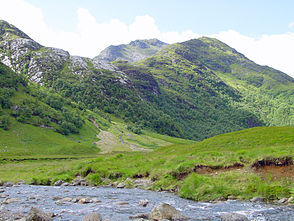Glen Nevis
| Glen Nevis | ||
|---|---|---|
|
Upper Glen Nevis |
||
| location | Highlands , Scotland | |
| Waters | River Nevis , Steall Falls | |
| Mountains | Grampian Mountains | |
| Geographical location | 56 ° 46 ′ N , 5 ° 2 ′ W | |
|
|
||
| length | approx. 20 km | |
The Glen Nevis ( Gaelic Gleann Nibheis ) is a valley ( glen ) in the Scottish Highlands . It is located in the Highland Council Area southeast of Fort William at the foot of Ben Nevis . The River Nevis flows through it, which flows into the bay of Loch Linnhe at Fort William . Glen Nevis is a popular hiking area for tourists. The starting point for visits is Fort William.
The Glen Nevis is divided into two larger sections, which are separated by a narrow gorge. The lower section runs for about 10 km to the west and south of Ben Nevis. This section includes the Fort William Youth Hostel and the Council Area's Glen Nevis Visitor Center . A narrow single track road runs to the end of this valley section . The valley then narrows to the River Nevis Gorge , where the River Nevis has dug deep into the rocks.
The upper section of the valley is bounded to the north by the foothills of Ben Nevis and other mountains such as the Aonach Mòr . To the south lies the Mamores mountain range, which is also over 1000 meters high , the highest peak of which is the 1132 meter high Binnein Mòr . The Glen Nevis then gradually widens towards Rannoch Moor and becomes progressively flatter. The Rannoch Moor is also the source of the River Nevis, known in the upper valley section as the Water of Nevis. Corrour Station on the West Highland Line , the highest and loneliest train station in Great Britain, can be reached via a hiking trail across the moor . The valley has a number of waterfalls , including the Steall Falls, the second highest waterfall in Scotland.
While the valley at the mouth of the River Nevis belongs to the settlement area of Fort William and is densely built up, there are only a few small settlement areas in the lower valley section. The upper part is no longer inhabited, in the vicinity of the Steall Falls remains of settlements that were dissolved in the course of the Highland Clearances can be seen.
Due to its scenic beauty, the valley is a popular excursion and hiking destination. It has therefore been used repeatedly as a location for films, for example for some Harry Potter films as well as for the films Highlander - There Can Only Be One , Highlander III - The Legend , Braveheart and Rob Roy .


